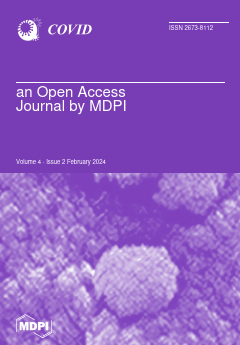Background: Several studies have linked coronavirus disease 2019 (COVID-19) risk to age and ABO blood groups. Variations in plasma angiotensin-converting enzyme 2 (ACE2) levels and blood counts have been reported, suggesting an association between disease severity and low lymphocyte levels. Aim: this study aimed to understand how these factors relate to COVID-19 in Ghanaian patients, considering geographical and demographic differences. Methods: Participants were recruited from six hospitals in Kumasi, Ghana, between June 2020 and July 2021. Nasopharyngeal swabs were taken to test for severe acute respiratory syndrome coronavirus 2 (SARS-CoV-2), and blood samples were collected for complete blood count testing, ABO/Rhesus typing, and assessment of plasma ACE2 levels. Demographic and COVID-19 severity data were gathered, and IBM SPSS version 25.0 was used for analysis. Results: Overall, 515 patients were enrolled, out of which 55.9% (
n = 288/515) were males and 50.3% (
n = 259/515) tested positive for SARS-CoV-2. The median age was 37 years (IQR = 26–53). Age was significantly associated with SARS-CoV-2 infection (
p = 0.002). The severe COVID-19 group was the oldest (70 years, IQR = 35–80) and presented with anaemia (haemoglobin, g/dL: 9.55, IQR = 7.85–11.93), leukocytosis (WBC × 10
3/μL: 15.87, IQR = 6.68–19.80), neutrophilia (NEUT × 10
6/μL: 14.69, IQR = 5.70–18.96) and lymphocytopenia (LYMPH × 10
6/μL: 0.47, IQR = 0.22–0.66). No association was found between SARS-CoV-2 positivity and ABO (
p = 0.711) or Rh (
p = 0.805) blood groups; no association was also found between plasma ACE2 levels and SARS-CoV-2 status (
p = 0.079). However, among COVID-19 participants, plasma ACE2 levels were significantly reduced in the moderate illness group (40.68 ng/mL, IQR = 34.09–48.10) compared with the asymptomatic group (50.61 ng/mL, IQR = 43.90–58.61,
p = 0.015). Conclusions: While there may be no real association between the ABO blood group, as well as plasma ACE2 levels, and SARS-CoV-2 infection in Ghanaian patients, older individuals are at a higher risk of severe disease. Anaemia, and leukocytosis with lymphocytopenia may be indicators of poor disease progression.
Full article





